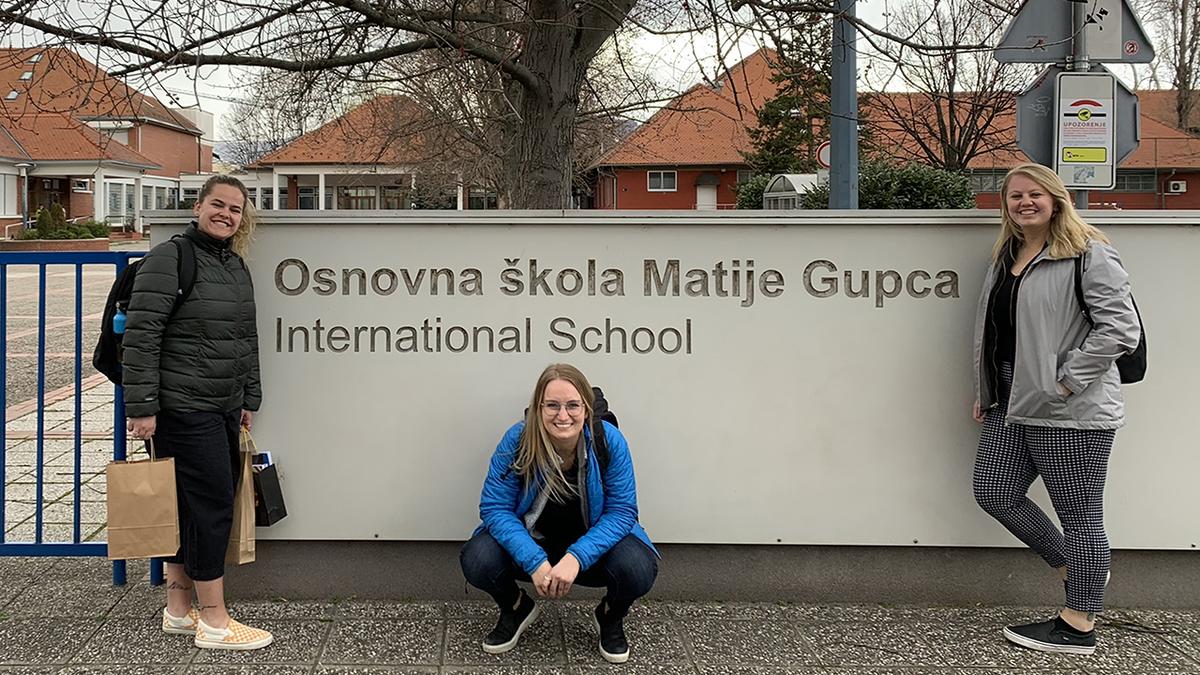Patti Harrold, a retired teacher from Oklahoma, was compelled to reach out to UMD recently to share her positive experience meeting three UMD students. "Too often you hear the bad about young people," says Harrold, "and then here these girls were just filled with curiosity and joy for life."
Harrold, along with her friend, fellow teacher, and traveling companion Julie Oppel, had nothing but praise for the students they met who are participating in UMD's International Student Teaching program. The students, Cass Welhouse, Alexia Bjerke, and Megan Blaszkowski were on a train from Brussels to Amsterdam before beginning their student teaching positions in Zagreb, Croatia when they met Harrold and Oppel.
After exchanging pleasantries, the students spoke with the teachers about their participation in the international student teaching program, which Harrold says sounded, "cutting edge." Harrold currently works with the University of Central Oklahoma to prepare students for practical experiences in student teaching and plans to share this experience with them in hopes of starting a program similar to UMD's.
Oppel was also impressed by the program and plans to recommend UMD to her future students. Both women expressed joy at seeing the young women of the program embarking on such a unique journey. "We've seen different examples of Americans who aren't a positive example, but these girls are great ambassadors for your school and the program. Just to see these bright girls going into this field is inspiring."
Helping future teachers expand their horizons
The international student teaching program has placements in Ireland, Croatia, and Slovenia. Starting next year, the program will expand to South Korea and Mexico. Students can teach for up to 12 weeks in any of these countries and the cost starts at $6836.
Future teachers interested in the program submit an application and essay for faculty review. Once a student is accepted, they work closely with Kim Riordan, the coordinator for the international student teaching program. Riordan says applicants should have "an absolute willingness to think beyond their box, beyond what they think is the only way to do things." Riordan adds, "The cultural immersion is something I just cannot prepare students enough for."
The three students who met Harrold and Oppel can attest to that. From the shorter workdays to the simple, meat-and-carbs meals, Croatia has been a culture shock for Bjerke, Blaszkowski, and Welhouse.
Blaszkowski was particularly surprised by the clothing norms, saying, "No one here is seen in sweatpants, no make-up, and messy hair. In the U.S., I go to the grocery store looking like that all the time."
For Welhouse, the food has been an adjustment. "I tend to cook for myself at home a lot," she says, "but I have had lunch almost every day at the school, which is usually traditional Croatian food." One such traditional dish, Ćevapi, consists of homemade sausage links made of beef, lamb, and/or pork and stuffed inside of warm bread and served with raw onions.
Bjerke has known she wanted to student teach abroad since coming to UMD. She is currently teaching the equivalent of kindergarten in Zagreb, Croatia along with fellow students Blaszkowski, who is teaching the equivalent of first grade, and Welhouse, who is teaching the equivalent of fourth grade. All three students agree that one of the most difficult challenges has been adapting to the cultural differences in the classroom.
Bjerke points out that the Croatian classroom doesn't have a strict structure. "The classroom management styles here, from what I have seen, are extremely different," she says. "I think the school is very focused on building strong social-emotional connections and preparing the students for the real world rather than just focusing so much on meeting academic standards."
Welhouse notes that the school schedule is less consistent in Croatia. She often finds herself checking her schedule multiple times a day. Blaszkowksi adds, "Everything has been surprising. I had an idea in my mind about how this trip would go and what the school would be like and I was so off. The opportunity to be here and the experiences I've had are so amazing!"
Despite the challenges and the cultural adjustment, Bjerke, Blaszkowski, and Welhouse all agree that they have already learned so much from this experience, such as how to communicate with non-fluent English speakers. "My favorite part of my placement is definitely the kids!" says Bjerke, "I have learned so much more from the kids themselves at this placement than I have learned from anyone else here!"
Pictured above: Cass Welhouse, Megan Blaszkowski, and Alexia Bjerke at Matija Gubec International School
This article was written by Abigail Hefter, who is majoring in political science and minoring in psychology. She's currently assisting with CEHSP communications.
Note: On March 15, the University of Minnesota system announced that all students abroad must return immediately to the U.S., due to the COVID-19 pandemic. We would like to note that this student teaching program in Croatia ended before the suspension of programs in Europe, and the students are home safely.
